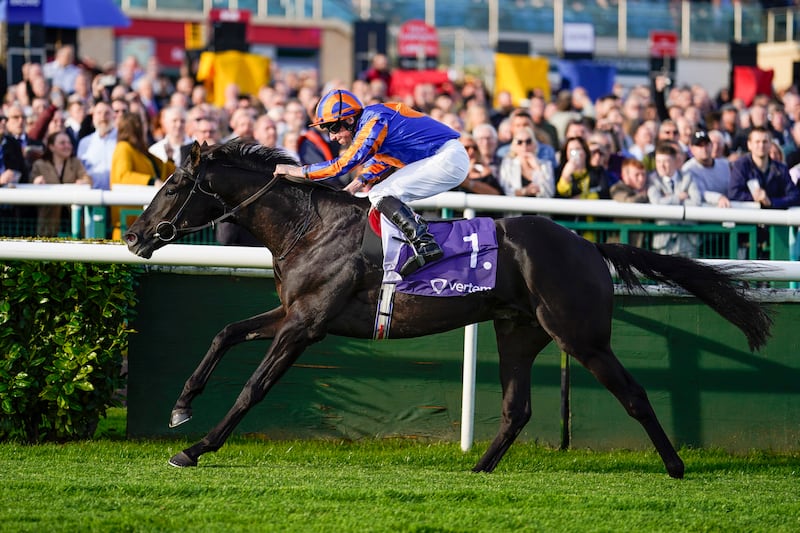Tomorrow is Derby Day which means Federico Tesio’s old line about the thoroughbred existing as a species not through science or expertise but because of a piece of wood at the Epsom finish line is getting its annual trot around.
The legendary Italian horseman’s opinion has become cliche, although irrelevance doesn’t accompany overuse since it’s an epigram that combines history and breeding, both of which have underpinned the Derby’s status as racing’s blue ribband event for more than two centuries.
A total of 14 colts will try to become the 244th winner of this renewal when the gates open at 1.30pm on Saturday.
The surreal atmosphere of the Covid pandemic Derby in 2020 was mirrored by a surprise 25-1 shot, Serpentine, Aidan O’Brien’s fourth string
Unlike the Kentucky Derby, for instance, no geldings are allowed, a reflection of how elite racing and breeding are two sides of the bloodstock coin. It’s also what makes the unhappy fate of Derby winner No 241 indicative of the great race’s slipping status.
The surreal atmosphere of the Covid pandemic Derby in 2020 was mirrored by a surprise 25-1 shot, Serpentine, Aidan O’Brien’s fourth string, managing to slip the field so that nothing got close enough to challenge him.
A regally bred son of the prepotent Galileo, Serpentine never did anything before or since to suggest he had such a performance in him. But when it counted, he delivered, and his spot in racing history is assured. It didn’t spare him getting the unkindest cut of all, though.
Last year it emerged that Serpentine had been gelded. Transferred to race in Australia, it was felt he had more to offer on the track than in the breeding shed. The procedure hadn’t been carried out on a Derby winner in well over a century.
Not anymore does Derby-winning prestige assure a stud career. Last weekend Serpentine finished runner-up in a handicap at Eagle Lane outside Brisbane. In seven starts in Australia, he has yet to win a race.
It’s a sobering tale of the Derby’s sliding stature in the business of making top-class stallions. In an industry ever more consumed with speed, form at the traditional classic distance of a mile-and-a-half has all but turned into a commercial negative.
Others such as Australia (2014) and Camelot (2012) have done comparatively well at stud almost despite having Derby success on their racing CV
Other recent Derby winners escaped Serpentine’s destiny but have still been banished to the breeding outposts and become National Hunt sires. The 2021 winner Adayar, subsequently a King George winner that year, is still in training in pursuit of a prestigious Group One at 10 furlongs.
Others such as Australia (2014) and Camelot (2012) have done comparatively well at stud almost despite having Derby success on their racing CV; so far has top-class accomplishment over a mile-and-a-half fallen out of vogue.
"You'd just about still call it good... I wouldn't say it is top of the ground yet, but it will be getting that way."
— Racing TV (@RacingTV) June 1, 2023
Epsom clerk of the course Andrew Cooper (@ACooperClerk) gives Nick Luck an update on the going ahead of the #DerbyFestival pic.twitter.com/I48sn2UJit
The irony is that the most important stallion of the last 20 years was an out-and-out mile-and-a-half runner. With the prejudice against stamina, even 2001 Derby hero Galileo struggled in the early years of his stallion career. His fee tumbled before his first crop emerged as exceptional.
European bloodstock’s short-sighted fixation with speed is anything but cheap and it has come at a long-term cost, part of which is the Derby’s declining prestige when it comes to defining excellence in the thoroughbred species.
Since as good a definition of class as any is the capacity to carry speed over distance it’s a regrettable trend that increasingly undermines Tesio’s mantra
Commercial imperatives mean the default route for modern Derby winners is to be dropped back in trip to a mile-and-a-quarter to try and prove they aren’t just about stamina. The impact on other top mile-and-a-half races — particularly the Irish Derby — has been significant.
Since as good a definition of class as any is the capacity to carry speed over distance it’s a regrettable trend that increasingly undermines Tesio’s mantra. The Derby’s old glories have always been part of its appeal. But it has been trading far too much on them for comfort.

Some salvation, however, could come from the other side of the world and the emergence of Japan as perhaps the world’s premier racing powerhouse.
Over the last 50 years, Japanese racing has progressed from a relative backwater to become a model towards which the sport’s more traditional centres in Europe and North America look with increasing envy. Crucial to that progress has been an industry focus on middle-distance accomplishment and breeding the soundness of bone and mind required to pull it off. Speed is valued, but the ability to carry it over a trip is prized to an extent almost unimaginable here.
That willingness to buck the speed trend has paid off in spades for Japan. By most any measure, and certainly in terms of results, they’ve got the balance right
Some evidence of that will be in the Derby field through Aidan O’Brien’s favourite, Auguste Rodin. He is a son of Deep Impact, still Japan’s most famous racehorse, who never raced shorter than 10 furlongs and won at the top level over two miles before becoming a major stallion influence.
That willingness to buck the speed trend has paid off in spades for Japan. By most any measure, and certainly in terms of results, they’ve got the balance right.
Since Japan’s influence is increasingly likely to dictate the market, it could also point to a much-needed future resurgence in the currency of those old-fashioned virtues that have always made the Derby racing’s supreme test of class.
Something For The Weekend
The last full brothers to win the Derby were Persimmon (1896) and Diamond Jubilee four years later. Military Order (1.30) bids to emulate Adayar and boasts much more convincing credentials at this stage of his career than his sibling did two years ago.
Maintaining the Derby theme, Sunday’s Prix du Jockey Club at Chantilly is likely to be run on quick conditions which American Flag (3.05) is unproven on. Having blown his chance with a dreadful start as an odds-on favourite for last month’s French Guineas, and taking the ground factor on trust, he could still be worth another classic shot at much bigger odds.

















